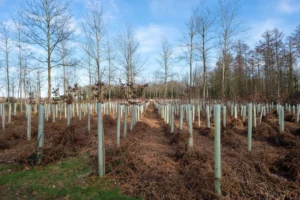
CCL volunteers on the Capitol steps for our annual group photo
Reflections from Capitol Hill: Climate advocacy and a moonshot mindset
By CCL volunteer Joel McKinnon
Each year, several hundred Citizens’ Climate Lobby volunteers travel to Washington, D.C., at their own expense to participate in CCL’s Summer Conference and Lobby Day, holding hundreds of meetings with legislators on Capitol Hill. This year, for the first time, I decided to join them. By the time it was over, I was left with a renewed sense of possibility—not only in what we can accomplish as climate advocates, but in how we connect as human beings in this critical work.

Joel McKinnon
Let’s start with the basics: I was there, suit and all. A rented one, to be exact. Somewhere between the personal awkwardness of being dressed like a businessman and the shoes that quickly turned into instruments of mild torture, I found myself reflecting on how odd and wonderful it is to do something so uncomfortable for something that matters so much. Climate work is rarely glamorous, but it does have moments of unexpected grace, and this event brought many.
Our meetings on the Hill were thoughtful, serious, and at times, deeply human. In Rep. Sam Liccardo’s office, there was a striking constellation of personal stories: a mother and daughter speaking with grace and clarity, a Spanish teacher reconnecting serendipitously with a former student who now serves on the congressional staff, and a husband and wife seasoned in CCL advocacy grounding the conversation with perspective and calm purpose. The discussion was energized, sincere, and open to meaningful dialogue.
The conversation with Rep. Jerry Panetta’s aide was similarly warm, frank, and collaborative. Our team was received with a sense of familiarity, a quiet nod to the long-term relationships we’ve built. The staffer’s stories of late-night phone calls during past legislative efforts, and her reflections on political realities, revealed the emotional labor behind policy work and the role we play as trusted outside partners.
But advocacy wasn’t the only kind of connection this trip offered.
I also carved out time for a different kind of fuel: reconnecting with people who’ve been part of my journey. I met up with my brother in Pittsburgh before the trip to watch my hometown team play baseball. I spent time with Tobias, a friend I’d met online and finally met in person in Philadelphia. And in D.C., I reunited with Darryl, an old bandmate and drummer, who took me on an inspiring side trip the Sunday before the conference.
We spent the afternoon at the Smithsonian National Air and Space Museum, where the Wright Brothers exhibit and the Race to the Moon wing stopped me in my tracks. One particular multimedia piece explored the cultural and political tensions of the 1960s — civil rights, war, economic disparity — all unfolding alongside an unprecedented effort of human collaboration and technical innovation that culminated in landing a person on the moon. It framed the moonshot not as a solitary feat, but as a symphony of effort from thousands of unsung contributors.
Standing there, I couldn’t help but draw the parallel to our climate crisis. The space race wasn’t just about rockets. It was about will, imagination, and urgency. It required us to act across divides, invent new technologies, and, most importantly, believe we could do something no one had done before.
That exhibit, quiet, moving, and brilliantly assembled, reminded me that the path ahead on climate isn’t hopeless. It’s just hard. But we as a people have done hard things, nearly impossible things, before.
So yes, I’ll remember the talking points. But I’ll also remember the aching shoes, the laughter with friends, the warmth of a chance hallway encounter, and that lingering feeling I had standing next to the Apollo capsule. We can do this if we have the will, the spirit, and the desire to put in the work it takes. This trip gave me a sense of what’s possible when all seems chaotic and confused. We are still a government of, by, and for the people. And we have to reach further than ever before to do the right thing for the future of the planet we live on.
Joel McKinnon is a volunteer in CCL’s San Mateo, California, chapter.
The post Reflections from Capitol Hill: Climate advocacy and a moonshot mindset appeared first on Citizens' Climate Lobby.
Reflections from Capitol Hill: Climate advocacy and a moonshot mindset
Greenhouse Gases
Warming due to tropical deforestation linked to 28,000 ‘excess’ deaths per year
Warming driven by deforestation caused an extra 28,000 heat-related deaths per year across Africa, South America and Asia over 2001-20, new research finds.
The study, published in Nature Climate Change, is the first to look at human health impacts of warming caused specifically by tropical deforestation, as opposed to the burning of fossil fuels, its lead author tells Carbon Brief.
The authors find that deforestation alone drove, on average, 0.45C of warming in the tropics over 2001-20, accounting for 64% of the total warming in regions with tropical forest loss.
They also find that tropical deforestation over 2001-20 exposed 345 million people to “local warming”, in addition to the warming they were already facing due to global warming.
Six out of every 100,000 people living in deforested areas died as a result of deforestation-induced warming during this time, they warn.
This number is higher in south-east Asia, with Vietnam setting a record of, on average, 29 deaths per 100,000 people.
A researcher who was not involved with the study tells Carbon Brief that the “sobering” paper “reframes tropical deforestation as not only a carbon emissions and ecological issue, but also a critical public health concern”.
Tropical deforestation
Tropical forests, mainly distributed across South America, Africa and Asia, account for 45% of global forest cover.
These regions are well-known for their high biodiversity and the crucial ecosystem services that they provide, such as carbon storage.
However, tropical forest loss is on the rise.
A record 6.7m hectares of previously intact tropical forest was lost last year, mainly due to fires and land clearing for agriculture. As the planet warms, worsening heat and drought extremes are also causing trees to become less resilient to change, resulting in forest degradation.
The new study uses data from the Global Land Analysis and Discovery laboratory at the University of Maryland to assess how tropical forest cover has changed year on year. The authors find that over 2001-20, a total of 1.6m square kilometres (160m hectares) of tropical forest was lost globally. This is shown on the map below, where blue indicates high forest loss and yellow indicates low loss.

The authors find the largest forest loss was in central and South America, but also highlight “extensive” loss in south-east Asia and tropical Africa.
Forest warming
Tropical deforestation has a wide range of negative consequences, including decreasing biodiversity, releasing carbon into the atmosphere and threatening the safety of Indigenous communities.
Loss of tree cover can also affect local temperatures by influencing the water cycle.
Water is constantly moving from the surface of the land into the atmosphere through a process called evapotranspiration. Plants play a crucial part in this process by moving water from the soil up through their roots and into their leaves, where it evaporates, cooling the air above. When trees are cut down, this cooling effect is reduced.
The authors use data of land surface temperatures from the NASA MODIS satellite to map warming in tropical regions over 2001-20. These results are shown in the map below, where red indicates warming and blue indicates cooling.

The authors find that between 2001-03 and 2018-20, surface temperatures increased by 0.34C in tropical central and South America, 0.1C in tropical Africa and 0.72C in south-east Asia. They add that “areas of forest loss coincide with areas of strong positive change in temperature across many regions of the tropics”.
By comparing their deforestation and surface warming maps, the authors find that deforested regions of the tropics saw an average of 0.7C warming over 2001-20, while areas that “maintained forest cover” saw an increase of only 0.2C.
By comparing the change in temperature in deforested regions with that in neighbouring locations without forest loss, they find that deforestation alone caused 0.45C of warming in the tropics over 2001-20 – accounting for 64% of total warming experienced over those regions.
Heat exposure
High temperatures can be deadly.
During periods of extreme heat, people can suffer from heat stroke and exhaustion – and even die. Those with underlying health conditions are at higher risk of fatal complications.
The authors use data from Oak Ridge National Laboratory’s LandScan to map where people live in the tropics. They estimate that 425 million people live in regions that were exposed to tropical deforestation over 2001-20, and just over three-quarters of them were exposed to warming as a result of the loss of forest cover.
Finally, the authors estimated “heat-related excess mortality” due to nearby tropical deforestation.
Using data from the 2019 Global Burden of Disease study, they determine the number of “non-accidental” deaths in each deforested tropical area. This excludes deaths from “external” causes, such as accidents and suicides, but includes “internal” causes, such as disease.
The researchers then used previously published “temperature-mortality” relationships for different countries. These relationships show the link between temperature and excess mortality rate, indicating the percentage increase in mortality for every degree of warming.
These relationships vary between countries, as people in hotter regions are generally better adapted to extreme heat.
By combining the data on local warming due to deforestation, temperature-mortality relationships and the non-accidental mortality data, the authors calculated how many non-accidental deaths would have been expected in deforested regions if they had not warmed due to the loss of forest cover.
By comparing the real and counterfactual mortality rates, the authors were able to calculate the total mortality burden due to tropical deforestation-induced warming.
Overall, the authors find that tropical deforestation drove an additional 28,300 deaths every year over 2001-20, accounting for 39% of the total heat-related mortality from global climate change and deforestation combined over locations of forest loss.
The study finds that, on average, six out of every 100,000 people living in deforested areas died as a result of deforestation-induced warming. However, these numbers vary by country.
The chart below shows the average annual deaths due to deforestation-induced heat per 100,000 people living in areas of forest loss.
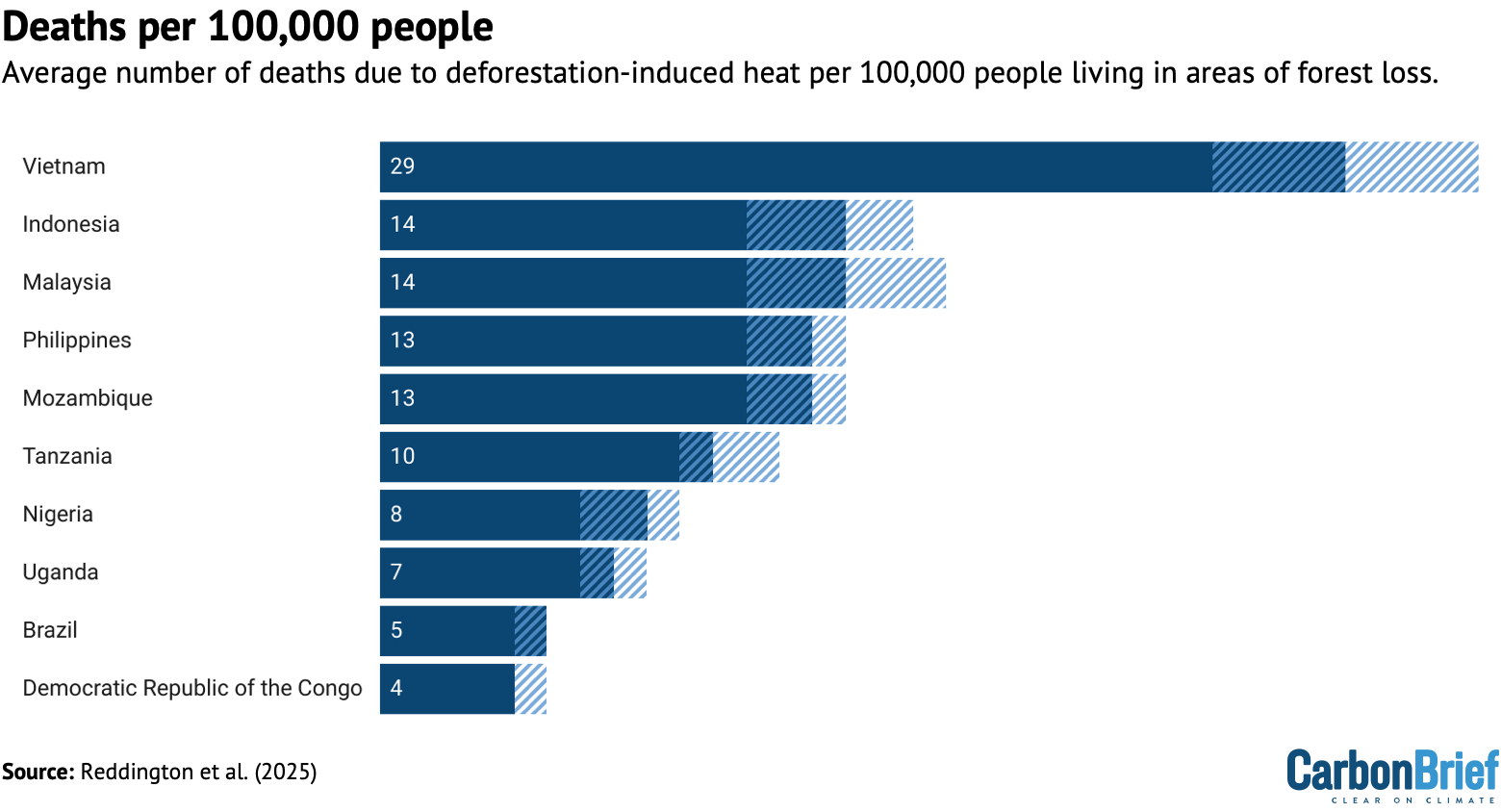
Dr Carly Reddington is a research fellow at the University of Leeds and lead author of the study. She tells Carbon Brief that it is the “first study to look at human health impacts of tropical deforestation-induced warming”.
Dr Nicholas Wolff, a climate change scientist at the Nature Conservancy who was not involved with the study, tells Carbon Brief that the paper is “sobering”. He adds that it “reframes tropical deforestation as not only a carbon emissions and ecological issue, but also a critical public health concern”.
Data-scarce
The authors note that there are no country-specific heat vulnerability indices available for African countries. To develop their data for African countries, they used the average heat vulnerability index for South America.
Reddington tells Carbon Brief that Africa is the most “uncertain region” in the study and tells Carbon Brief that “more data is really crucial” to develop more accurate estimates.
Wolff tells Carbon Brief that extrapolating heat-mortality relationships “from data-rich regions to data-poor ones” is a “common practice in global-scale climate-health research”.
He praises the overall methodology as “innovative, transparent and scientifically sound, with appropriate caveats”.
Dr Luke Parsons, a climate modelling scientist at the Nature Conservancy, tells Carbon Brief that the conclusions are “robust”. However, he notes some “methodological issues” with the paper, such as the fact that all results are modelled, rather than measured.
He tells Carbon Brief that future work could assess “near-surface air temperature and humidity changes associated with deforestation, as well as study regional air temperature changes beyond deforested areas”.
While the new study focuses on warming within one square kilometre of forest loss, Reddington tells Carbon Brief that “deforestation is associated with warming up to 100km away”.
Furthermore, the study notes that the increase in deaths due to excess heat is likely to affect the most vulnerable members of society the most. It says:
“Vulnerable populations, particularly traditional and Indigenous communities, often live near deforested areas and face limited access to resources and infrastructure needed to cope with the combination of rising temperatures and environmental changes caused by deforestation and climate change.”
Wolff also stresses this disparity, adding that “many of these communities depend on forest clearing for agriculture, income and survival, and are forced to make difficult choices between short-term economic needs and long-term health and environmental stability”.
The authors also note that deforestation can drive a range of other interacting health problems, which were not considered in this study. For example, deforestation is linked to a rise in zoonotic diseases, such as malaria.
Dr Vikki Thompson, a climate scientist at the Royal Netherlands Meteorological Institute who was not involved in the study, says that the findings of the paper are “relevant to everyone”. She continues:
“We can reduce impacts of extreme heat by planting more trees and reducing deforestation everywhere, on both local and international scales.”
The post Warming due to tropical deforestation linked to 28,000 ‘excess’ deaths per year appeared first on Carbon Brief.
Warming due to tropical deforestation linked to 28,000 ‘excess’ deaths per year
Greenhouse Gases
Appropriations in Action: CCLers Rally to Defend Key Climate & Clean Energy Programs
Appropriations in Action: CCLers Rally to Defend Key Climate & Clean Energy Programs
By Elissa Tennant
Last month, CCLers mobilized en masse to contact their members of Congress ahead of the appropriations process. Together, we sent 12,859 emails to lawmakers encouraging them to fund key climate and clean energy programs.
Every year, Congress decides which programs and agencies to fund, and what level to fund them at. This is referred to as the appropriations process.
CCL hasn’t weighed in on this process before, but we felt this is an important avenue to urge Congress to reassert their authority. This action helped preserve our pathway to success, which we’ve identified is through work with Congress. Additionally, the Trump administration’s fiscal year 2026 (FY26) budget is seeking dramatic cuts to climate and clean energy programs, and we felt our voices could make a valuable impact.
The process is ongoing, but early signs from Congress are promising. On September 4, the House passed an energy and water appropriations bill. There’s no good way to sugarcoat it: This bill definitely included some harmful cuts to climate and clean energy programs, but the cuts are much less significant than those outlined in the President’s version of the budget.
During the debate on the bill, Republican members of Congress, including the chairman of the Energy and Water Development and Related Agencies Subcommittee, Rep. Chuck Fleischmann (R-TN), pushed back on completely gutting those programs. Publicly, he stated these programs are bipartisan and have his support.
Springing into Action
Congress passes appropriations bills each year to fund government operations, usually by the September 30 deadline (the start of the federal fiscal year).
We told Congress to support robust funding for programs at NOAA, NASA, and the Department of Energy that will help preserve critical science and research, strengthen clean energy infrastructure, and ensure that America’s grid can meet rising demand.
We asked our representatives to reject proposed cuts to these agencies:
National Aeronautics and Space Administration (NASA)
NASA’s Earth-orbiting satellites and new technologies have helped scientists collect many different types of information about our planet and its climate. But the White House requested to slash NASA’s science funding by 47%.
National Oceanic and Atmospheric Administration (NOAA)
NOAA plays a critical role in weather forecasting, extreme weather warnings, and climate science. The agency’s research is also the gold standard for tracking the levels of carbon dioxide in the atmosphere and oceans, publishing that data publicly for America and the international community, and modeling/forecasting changes as a result. Yet the Trump administration’s proposed 2026 budget sought $2.2 billion cuts in NOAA research endeavors, grant programs and other initiatives, including dissolving the Office of Oceanic and Atmospheric Research.
Department of Energy (DOE)
The Department of Energy’s Office of Energy Efficiency and Renewable Energy (EERE) and Advanced Research Projects Agency (ARPA-E) are essential for energy innovation and reliability. EERE funds early-stage research and development activities to develop efficient energy and different types of energy sources, which is critical for America’s global energy leadership. Yet the White House had proposed cutting this office’s budget by 74%.
ARPA-E develops cutting edge energy technologies that keep us ahead of global competitors while driving down costs. It’s extremely bipartisan and well-supported in Congress; yet the White House’s budget proposes a 57% cut to this agency.
We Lobbied on This, Too!
If this all sounds familiar to you, it’s because we lobbied on this issue in July, too! During our 402 meetings on Capitol Hill, we asked Congress to support the clean energy transition for affordable and reliable power as well as a safer climate.
As a tactic to achieve this ask, we requested Congress support targeted programs that enable clean energy to compete, scale, and deliver dependable and affordable power to Americans. Specifically, we mentioned the DOE programs EERE and ARPA-A as two key programs to lower energy costs through innovation and clean energy investment.
Our mobilization built on this ask by generating 12,859 messages to Congress between August 13 and September 6.
The Results So Far
The appropriations process is a long one, but it’s a key focus for Congress right now. Appropriations are mostly negotiated behind the scenes, but we’re starting to see some results. The House passed its energy and water appropriations bill early in September, which significantly reduced cuts to Department of Energy programs we lobbied and mobilized around protecting. During the debate, Republican members of the committee, including the committee chair, Rep. Chuck Fleischmann (R-TN) pushed back on additional major cuts to the DOE programs.
While this specific bill will not necessarily be what’s ultimately signed into law (the Senate and House still have to negotiate and agree), we’ve already made a difference. Thanks to everyone who sent one of our 12,859 contacts to Congress. Remember, it’s timely actions like these that create a major impact in our country’s climate policies.
Keep the momentum going! Get loud for the climate and encourage others to do the same. View our latest actions here.
The post Appropriations in Action: CCLers Rally to Defend Key Climate & Clean Energy Programs appeared first on Citizens' Climate Lobby.
Appropriations in Action: CCLers Rally to Defend Key Climate & Clean Energy Programs
Greenhouse Gases
IEA reiterates ‘no new oil and gas needed’ if global warming is limited to 1.5C
The world would not need to invest in new oil and gas projects if demand for the fuels fell in line with the 1.5C limit on global warming, says the International Energy Agency (IEA).
The agency has been under attack from the Trump administration in the US for saying that fossil-fuel use is on track to peak this decade, given current policies and firm political pledges.
But, in a new report, the agency reiterates its 2021 finding that no investment in new oil and gas would be needed in a 1.5C world, albeit with some caveats.
The report also sets out how the oil-and-gas industry has been needing to “run fast to stand still”, spending around $500bn per year just to keep output at today’s levels.
It says this is due to output falling faster than previously thought at the world’s oil and gas fields, with an increasing reliance on shale oil and gas projects that face rapid rates of decline.
Amid growing calls for further licensing in the North Sea, the IEA also notes that new exploration licenses take an average of nearly 20 years to deliver additional oil and gas production.
Turning unconventional
The IEA report begins by arguing that discussions on the future of oil and gas “tend to focus on the outlook for demand, with much less consideration given to how the supply picture could develop”.
This is why the IEA has published a report on the rate of decline at existing oil and gas fields, as well as looking at where these fuels come from today and how this might change in the future.
Over the past quarter-century, global oil supplies have risen by a third, as shown in the figure below. At the same time, the source of those supplies has shifted towards “unconventional” resources, such as “tight oil” from shale formations (red) and oil sands (orange).

Shale gas is also behind much of the growth in global gas production over the past 25 years, shown by the green wedge in the figure below.
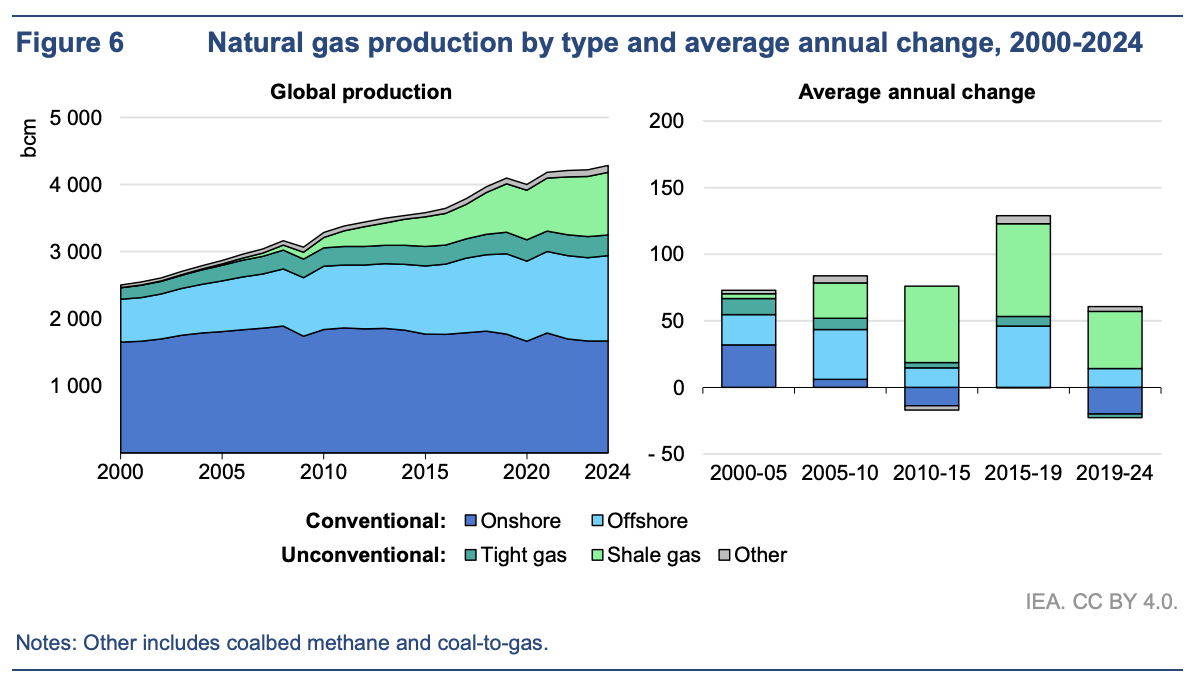
Accelerating decline
The shift towards unconventional resources, such as shale oil and gas, means that the output from existing fields will decline ever-more steeply without continued investments.
Indeed, the IEA report shows that this is already the case, with global “decline rates” for both oil and gas getting steeper – and the trend set to accelerate – as shown in the figure below, for gas only.
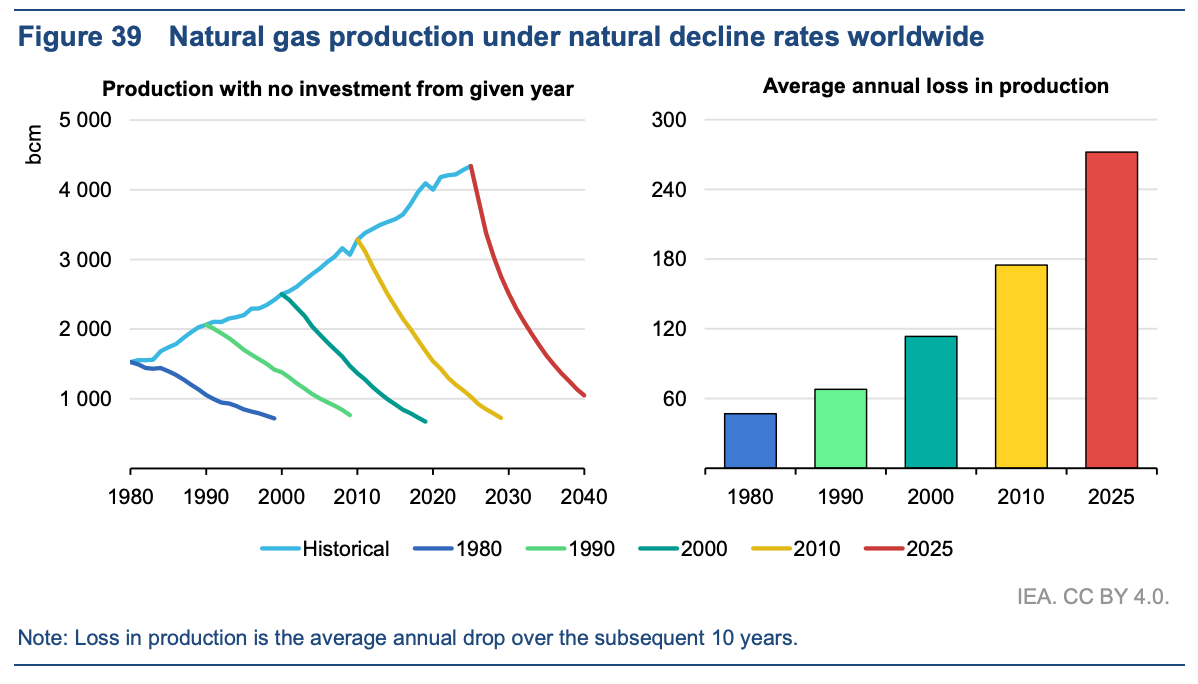
The consequence of these accelerating rates of decline is that the oil-and-gas industry is already needing to “run fast to stand still”, the IEA report explains.
It notes that nearly 90% of annual upstream investment in the sector since 2019 has been “dedicated to offsetting production declines rather than to meet demand growth”.
The industry needs to invest around $500bn per year, just to maintain current output, it says.
With investment set to reach $570bn in 2025, the IEA notes that this is enough to sustain “modest” production growth, but only a “small drop” away from flat or declining output.
The IEA also notes that around the world, on average, there is a delay of nearly 20 years from the issuing of oil and gas exploration licenses, until additional production starts to flow. It explains:
“This includes five years on average to discover the field, eight years to appraise and approve it for development, and six years to construct the necessary infrastructure and begin production.”
(In a recent speech pledging to “maximise extraction” of oil and gas from the North Sea, if elected, the UK’s opposition Conservative leader Kemi Badenoch talked of the need for new licenses.)
Need for new investment?
The IEA report goes on to show that without continued investment in maintaining output, global oil and gas production would plummet, as shown in the figure below.
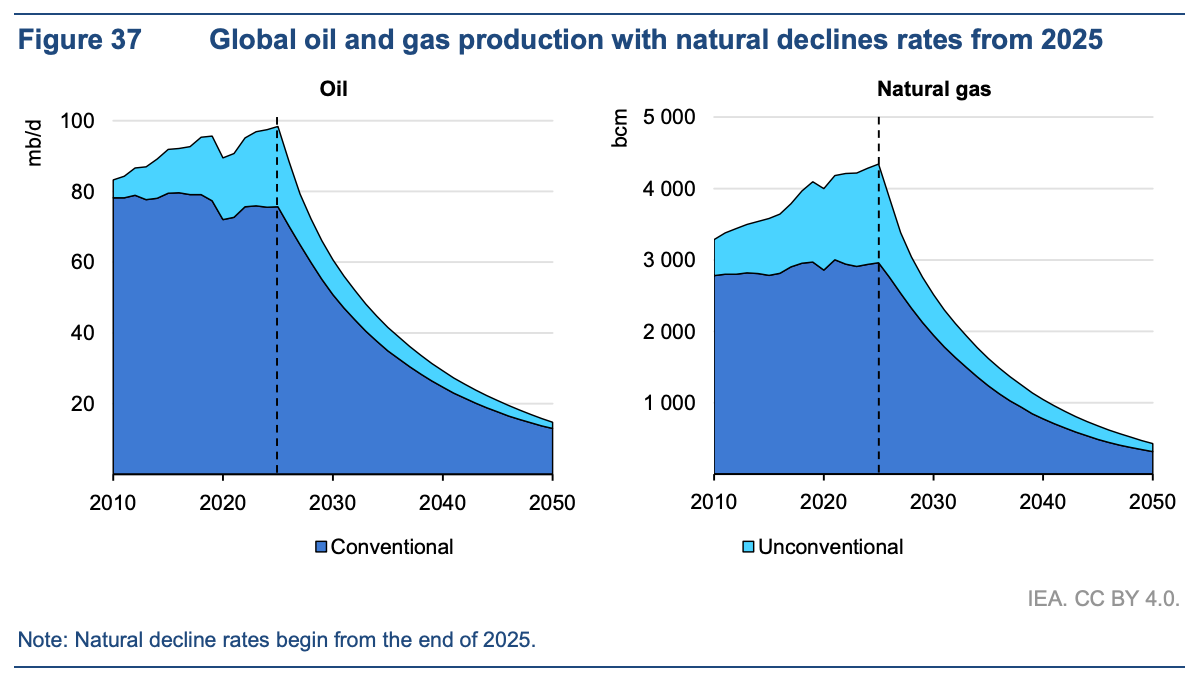
The Financial Times said the IEA report illustrated the “costly battle” facing the oil-and-gas sector if it wants to maintain current output.
However, the newspaper added that the sector would likely welcome the findings:
“The IEA’s findings are likely to be greeted enthusiastically by the oil industry, which has consistently maintained that it needs to spend heavily to maintain its current production levels.”
The catch is that the report also spells out the implications of falling demand, in a world that limits warming to below 1.5C above pre-industrial levels.
In the 1.5C-compliant “NZE scenario”, the IEA says that a “huge acceleration in the pace of energy transitions relative to current trends” would see oil and gas demand falling dramatically.
It adds that if this drop in demand were to happen, then no investment in new oil and gas production would be needed, as shown in the figure below. Specifically, the IEA report says:
“The pace of demand reduction in the NZE [1.5C] scenario is therefore sufficiently rapid that, in aggregate, no new long lead-time conventional upstream projects would need to be approved for development.”
(The IEA says that even in this 1.5C-compliant “NZE scenario”, there would still need to be some investment in “existing and approved” projects, to balance decline rates.)
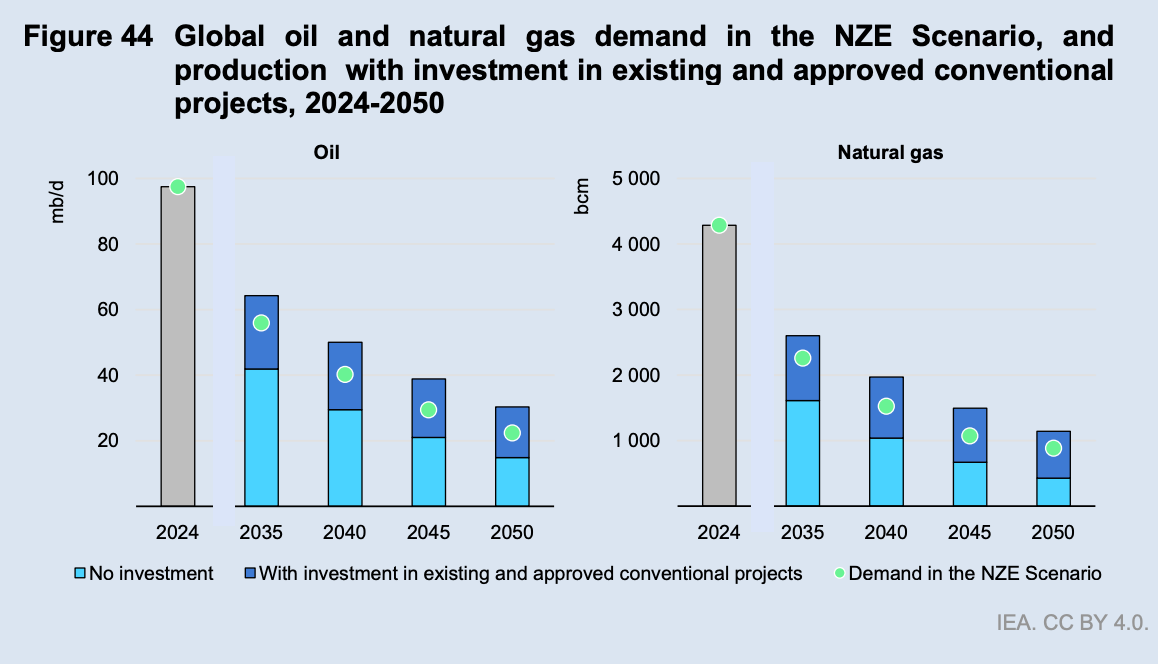
The new report, thus, reiterates the IEA’s previous finding that no investment in new oil and gas would be needed if the world got onto a 1.5C path.
However, it puts the emphasis more firmly on the need for demand to decline, in order to eliminate the need for new investment, contrasting with the way this finding has been widely reported.
In its coverage of the 2021 finding, for example, the Guardian reported that oil and gas development “must stop…if the world is to stay within safe limits”.
On the contrary, the new IEA report says that investment in new oil-and-gas development will be needed to meet demand, unless demand is dramatically reduced in line with the 1.5C limit.
In addition to making this point more firmly, the IEA report notes that a swathe of the highest-cost oil and gas projects in the world would need to close early – effectively becoming stranded assets – if demand for the fuels declines in line with the 1.5C limit. It says:
“[T]o ensure a smooth balance between supply and demand, declines in demand in the NZE scenario would lead to the early closure of several higher cost projects before they reach the end of their technical lifetimes. In 2050, for example, around 8mb/d of oil production and 250bcm of gas production would be retired earlier than would be implied by observed decline rates.”
The post IEA reiterates ‘no new oil and gas needed’ if global warming is limited to 1.5C appeared first on Carbon Brief.
IEA reiterates ‘no new oil and gas needed’ if global warming is limited to 1.5C
-
Climate Change2 years ago
Spanish-language misinformation on renewable energy spreads online, report shows
-
Climate Change Videos2 years ago
The toxic gas flares fuelling Nigeria’s climate change – BBC News
-

 Greenhouse Gases1 year ago
Greenhouse Gases1 year ago嘉宾来稿:满足中国增长的用电需求 光伏加储能“比新建煤电更实惠”
-

 Climate Change1 year ago
Climate Change1 year ago嘉宾来稿:满足中国增长的用电需求 光伏加储能“比新建煤电更实惠”
-

 Carbon Footprint1 year ago
Carbon Footprint1 year agoUS SEC’s Climate Disclosure Rules Spur Renewed Interest in Carbon Credits
-
Climate Change2 years ago
Why airlines are perfect targets for anti-greenwashing legal action
-
Climate Change1 month ago
Guest post: Why China is still building new coal – and when it might stop
-
Renewable Energy2 months ago
US Grid Strain, Possible Allete Sale

